Zimmermann Telegram
The Zimmermann Telegram (or Zimmermann Note or Zimmerman Cable) was a secret diplomatic communication issued from the German Foreign Office in January 1917 that proposed a military alliance between Germany and Mexico. If the United States entered World War I against Germany, Mexico would recover Texas, Arizona, and New Mexico. The telegram was intercepted and decoded by British intelligence.
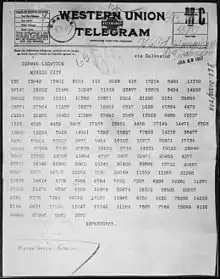
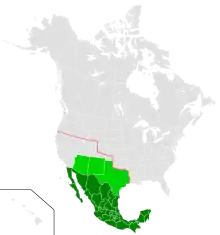
Revelation of the contents enraged Americans, especially after German Foreign Secretary Arthur Zimmermann publicly admitted on March 3 that the telegram was genuine, helping to generate support for the United States' declaration of war on Germany in April.[1] The decryption was described as the most significant intelligence triumph for Britain during World War I,[2] and one of the earliest occasions on which a piece of signal intelligence influenced world events.[3]
Telegram content
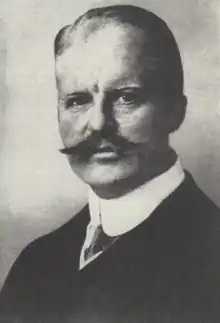
The message came in the form of a coded telegram dispatched by Arthur Zimmermann, a Staatssekretär (a top-level civil servant) in the Foreign Office of the German Empire on 19 January 1917. The message was sent to the German ambassador to Mexico, Heinrich von Eckardt.[4] Zimmermann sent the telegram in anticipation of the resumption of unrestricted submarine warfare by Germany on 1 February, which the German government presumed would almost certainly lead to war with the United States. The telegram instructed Eckardt that if the United States appeared certain to enter the war, he was to approach the Mexican Government with a proposal for military alliance with funding from Germany.
The decoded telegram is as follows:
We intend to begin on the first of February unrestricted submarine warfare. We shall endeavor in spite of this to keep the United States of America neutral. In the event of this not succeeding, we make Mexico a proposal of alliance on the following basis: make war together, make peace together, generous financial support and an understanding on our part that Mexico is to reconquer the lost territory in Texas, New Mexico, and Arizona. The settlement in detail is left to you. You will inform the President of the above most secretly as soon as the outbreak of war with the United States of America is certain, and add the suggestion that he should, on his own initiative, invite Japan to immediate adherence and at the same time mediate between Japan and ourselves. Please call the President's attention to the fact that the ruthless employment of our submarines now offers the prospect of compelling England in a few months to make peace.
Signed, ZIMMERMANN
Background
Previous German efforts to promote war
Germany had long sought to incite a war between Mexico and the United States, which would have tied down American forces and slowed the export of American arms to the Allies.[5] The Germans had engaged in a pattern of actively arming, funding, and advising the Mexicans, as shown by the 1914 Ypiranga Incident[6] and the presence of German advisors during the 1918 Battle of Ambos Nogales. German Naval Intelligence officer Franz von Rintelen had attempted to incite a war between Mexico and the United States in 1915, giving Victoriano Huerta $12 million for that purpose.[7] The German saboteur Lothar Witzke, responsible for the March 1917 munitions explosion at the Mare Island Naval Shipyard in the San Francisco Bay Area,[8] and possibly responsible for the July 1916 Black Tom explosion in New Jersey, was based in Mexico City. The failure of United States troops to capture Pancho Villa in 1916 and the movement of President Carranza in favor of Germany emboldened the Germans to send the Zimmermann note.[9]
The German provocations were partially successful. President Woodrow Wilson ordered the military invasion of Veracruz in 1914 in the context of the Ypiranga Incident and against the advice of the British government.[10] War was prevented thanks to the Niagara Falls peace conference organized by the ABC nations, but the occupation was a decisive factor in Mexican neutrality in World War I.[11] Mexico refused to participate in the embargo against Germany and granted full guarantees to the German companies for keeping their operations open, specifically in Mexico City.[12] These guarantees lasted for 25 years; coincidentally, it was on 22 May 1942 that Mexico declared war on the Axis Powers after the loss of two Mexican-flagged tankers that month to Kriegsmarine U-boats.
German motivation for the telegram
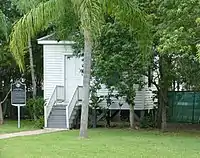
The Zimmermann Telegram was part of an effort carried out by the Germans to postpone the transportation of supplies and other war materials from the United States to the Allied Powers that were at war with Germany.[13] The main purpose of the telegram was to make the Mexican government declare war on the United States in hopes of tying down American forces and slowing the export of American arms.[14] The German High Command believed they would be able to defeat the British and French on the Western Front and strangle Britain with unrestricted submarine warfare before American forces could be trained and shipped to Europe in sufficient numbers to aid the Allied Powers. The Germans were encouraged by their successes on the Eastern Front into believing that they would be able to divert large numbers of troops to the Western Front in support of their goals. The Mexicans were willing to consider the alliance but declined the deal after Americans were informed of the telegram.
Mexican response
Mexican President Venustiano Carranza assigned a military commission to assess the feasibility of the Mexican takeover of their former territories contemplated by Germany.[15] The generals concluded that it would be neither possible nor even desirable to attempt such an enterprise for the following reasons:
- Mexico was in the midst of a civil war, and Carranza's position was far from secure. A declaration of war by his regime would have provided an opportunity for opposing factions to align with the United States and Allied Powers in exchange for diplomatic recognition.
- The United States was far stronger militarily than Mexico was. Even if Mexico's military forces were completely united and loyal to a single regime, no serious scenario existed under which they could invade and win a war against the United States.
- Germany's promises of "generous financial support" were very unreliable. The German government had already informed Carranza in June 1916 that they were unable to provide the necessary gold needed to stock a completely independent Mexican national bank.[16] Even if Mexico received financial support, it would still need to purchase arms, ammunition, and other needed war supplies from the ABC nations (Argentina, Brazil, and Chile), which would strain relations with them, as explained below.
- Even if by some chance Mexico had the military means to win a conflict against the United States and reclaim the territories in question, Mexico would have severe difficulty conquering and pacifying a large English-speaking population that was both used to self-government and better supplied with arms than most other civilian populations.
- Other foreign relations were at stake. The ABC nations organized the Niagara Falls peace conference in 1914 to avoid a full-scale war between the United States and Mexico over the United States occupation of Veracruz. If Mexico were to enter war against the United States, it would strain relations with those nations.
The Carranza government was recognized de jure by the United States on 31 August 1917 as a direct consequence of the Zimmermann telegram since recognition was necessary to ensure Mexican neutrality in World War I.[17][18] After the military invasion of Veracruz in 1914, Mexico did not participate in any military excursions with the United States in World War I,[11] thus ensuring that Mexican neutrality was the best outcome that the United States could hope for, even if Mexican neutrality allowed German companies to keep their operations in Mexico open.[12]
British interception
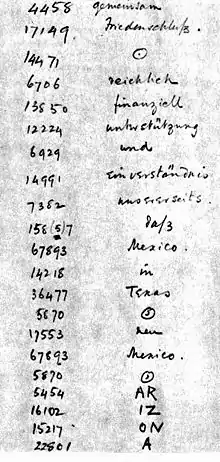
Zimmermann's office sent the telegram to the German embassy in the United States for re-transmission to Eckardt in Mexico. It has traditionally been claimed that the telegram was sent over three routes: transmitted by radio and also sent over two trans-Atlantic telegraph cables operated by neutral governments (the United States and Sweden) for the use of their diplomatic services, but it has been established that two methods were used. The Germans delivered the message to the United States embassy in Berlin, and it then passed by diplomatic cable first to Copenhagen and then to London for onward transmission over transatlantic cable to Washington.[19]
Direct telegraph transmission of the telegram was impossible because the British had cut the German international cables at the outbreak of war. However Germany was able to communicate wirelessly through the Telefunken plant (operating under Atlantic Communication Company) in West Sayville, New York, where the telegram was relayed to the Mexican Consulate. Ironically, the station was under control of the U.S Navy, who operated it for Atlantic Communication Company, the American subsidiary of the German entity.
Additionally, the United States allowed limited use of its diplomatic cables with Germany to communicate with its ambassador in Washington. The facility was supposed to be used for cables connected with President Woodrow Wilson's peace proposals.[19]
The Swedish cable ran from Sweden, and the United States cable from the United States embassy in Denmark. However, neither cable ran directly to the United States. Both cables passed through a relay station at Porthcurno, near Land's End, the westernmost tip of England. Here the signals were boosted for the long trans-oceanic jump. All traffic through the Porthcurno relay was copied to British intelligence, particularly to the codebreakers and analysts in Room 40 at the Admiralty.[20]
After their telegraph cables had been cut, the German Foreign Office appealed to the United States for use of their cable for diplomatic messages. President Wilson agreed in the belief both that such co-operation would sustain continued good relations with Germany and that more efficient German-American diplomacy could assist Wilson's goal of a negotiated end to the war. The Germans handed in messages to the United States embassy in Berlin, which were relayed to the embassy in Denmark and then to the United States by American telegraph operators. The United States placed conditions on German usage, most notably that all messages had to be in clear, or uncoded. However, Wilson later reversed the order and relaxed the wireless rules to allow coded messages to be sent.[21] The Germans assumed that the cable was secure and used it extensively.[20]
However, that put German diplomats in a precarious situation: they relied on the United States to transmit Zimmermann's note to its final destination, but the message's unencrypted contents would be deeply alarming to the Americans. The Germans persuaded US Ambassador James W. Gerard to accept it in coded form, and it was transmitted on 16 January 1917.[20]
In Room 40, Nigel de Grey had partially decoded the telegram by the next day.[19] By 1917, the diplomatic code 13040 had been along for many years and was old. Since Room 40 had had ample time to reconstruct it cryptanalytically, it was readable to a fair degree. Room 40 had previously obtained German cryptographic documents, including the diplomatic code 3512 (captured in the Mesopotamian campaign), which was a later, updated code, similar to, but not really related to code 13040, and naval code SKM (Signalbuch der Kaiserlichen Marine), useless for decoding the Zimmermann Telegram but valuable when it came to decoding naval traffic, which had been retrieved from the wrecked cruiser SMS Magdeburg by the Russians, who passed it to the British.[22]
Disclosure of the telegram would sway public opinion in the United States against Germany if the British could convince the Americans that the text was genuine, but Room 40 chief William Reginald Hall was reluctant to let it out because the disclosure would expose the German codes broken in Room 40 and British eavesdropping on the United States cable. Hall waited three weeks. During this period, de Grey and cryptographer William Montgomery completed the decryption. On 1 February Germany announced resumption of "unrestricted" submarine warfare, an act which led the United States to break off diplomatic relations with Germany on 3 February.[20]
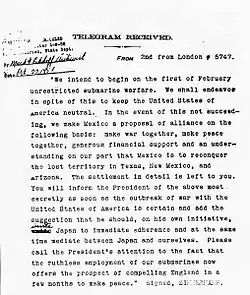
Hall passed the telegram to the British Foreign Office on 5 February, but still warned against releasing it. Meanwhile, the British discussed possible cover stories which would serve to explain to the Americans how they obtained the coded text of the telegram without admitting to their ability to intercept American diplomatic communications, which they would continue to do for another 25 years, and also to explain how they obtained the cleartext of the telegram without letting the Germans know that their codes were broken. Furthermore, the British needed to find a way to convince the Americans the message was not a forgery.[2]
For the first story, the British obtained the coded text of the telegram from the Mexican commercial telegraph office. The British knew that since the German embassy in Washington would relay the message by commercial telegraph, the Mexican telegraph office would have the coded text. "Mr. H", a British agent in Mexico, bribed an employee of the commercial telegraph company for a copy of the message. (Sir Thomas Hohler, the British ambassador in Mexico, claimed to have been "Mr. H" or at least involved with the interception in his autobiography.[23]) That coded text could be shown to the Americans without embarrassment.
Moreover, the retransmission was encoded with the older code 13040 and so by mid-February, the British had not only the complete text but also the ability to release the telegram without revealing the extent to which the latest German codes had been broken. (At worst, the Germans might have realized that the 13040 code had been compromised, but that was a risk worth taking against the possibility of United States entry into the war.) Finally, since copies of the 13040 codetext would also have been deposited in the records of the American commercial telegraph company, the British had the ability to prove the authenticity of the message to the United States government.[3]
As a cover story, the British could publicly claim that their agents had stolen the telegram's decoded text in Mexico. Privately, the British needed to give the Americans the 13040 code so that the United States government could verify the authenticity of the message independently with their own commercial telegraphic records, but the Americans agreed to back the official cover story. The German Foreign Office refused to consider a possible code break and instead sent Ambassador Eckardt on a witch-hunt for a traitor in the embassy in Mexico. (Eckardt indignantly rejected the accusations, and the Foreign Office eventually declared the embassy exonerated.)[20]
Use
On 19 February, Hall showed the telegram to Edward Bell, secretary of the United States Embassy in Britain. Bell, at first incredulous, thought that it was a forgery. Once Bell was convinced the message was genuine, he became enraged. On 20 February, Hall informally sent a copy to United States Ambassador Walter Hines Page. On 23 February, Page met with British Foreign Minister Arthur Balfour and was given the codetext, the message in German, and the English translation, by which stage the British had obtained a further copy in Mexico City and Balfour could obscure the real source with the half-truth that it had been "bought in Mexico".[24] Page then reported the story to President Woodrow Wilson on February 24, 1917, including details to be verified from telegraph-company files in the United States. Though Wilson felt "much indignation" toward the Germans and wanted to publish the Zimmermann Telegraph immediately after receiving it from the British, he delayed until March 1, 1917.[25]
American response

Many Americans at the time held anti-Mexican as well as anti-German views, and in Mexico there was a considerable amount of anti-American sentiment in return (thanks in no small part to the American occupation of Veracruz).[26] General John J. Pershing had long been chasing the revolutionary Pancho Villa for raiding into US territory and carried out several cross-border expeditions. News of the telegram further inflamed tensions between the United States and Mexico.
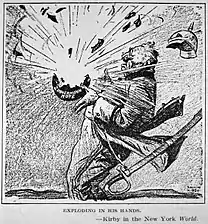
However, many Americans, particularly German and Irish Americans wished to avoid the conflict in Europe. Since the public had been told falsely that the telegram had been stolen in a decoded form in Mexico, the message was widely believed at first to be an elaborate forgery created by British intelligence. That belief, which was not restricted to pacifist and pro-German lobbies, was promoted by German and Mexican diplomats alongside some American newspapers, especially the Hearst press empire. That presented the Wilson administration with a dilemma. With the evidence the United States had been provided confidentially by the British, Wilson realized the message was genuine—but he could not make the evidence public without compromising the British codebreaking operation.
Any doubts as to the authenticity of the telegram were removed by Zimmermann himself. At a press conference on 3 March 1917, he told an American journalist, "I cannot deny it. It is true." Then, on 29 March 1917, Zimmermann gave a speech in the Reichstag in which he admitted the telegram was genuine.[27] Zimmermann hoped that Americans would understand that the idea was that Germany would only fund Mexico's war with the United States in the prior event of American entry into World War I.
On 1 February 1917, Germany began unrestricted submarine warfare against all ships in the Atlantic bearing the American flag, both passenger and merchant ships. Two ships were sunk in February, and most American shipping companies held their ships in port. Besides the highly provocative war proposal to Mexico, the telegram also mentioned "ruthless employment of our submarines". Public opinion demanded action. Wilson had previously refused to assign US Navy crews and guns to the merchant ships. However, once the Zimmermann note was public, Wilson called for arming the merchant ships, but anti-war elements in the United States Senate blocked his proposal.[28]
On 6 April 1917, Congress voted to declare war on Germany; Wilson had asked Congress for "a war to end all wars" that would "make the world safe for democracy".[29]
Woodrow Wilson considered another military invasion of Veracruz and Tampico in 1917–1918,[30][31] so as to pacify the Tehuantepec Isthmus and Tampico oil fields and ensure their continued production during the civil war,[31][32] but this time the relatively new Mexican President Venustiano Carranza threatened to destroy the oil fields in the event that the Marines landed there.[33][34]
Japanese response
The government of Japan, another nation mentioned in the Zimmerman Telegram, was already involved in World War I, on the side of the Allied Powers against Germany. The Japanese government later released a statement that Japan was not interested in changing sides and attacking America.[35]
Autograph discovery
In October 2005, it was reported that an original typescript of the decoded Zimmermann Telegram had recently been discovered by an unnamed historian who was researching and preparing an official history of the United Kingdom's Government Communications Headquarters (GCHQ). The document is believed to be the actual telegram shown to the American ambassador in London in 1917. Marked in Admiral Hall's handwriting at the top of the document are the words: "This is the one handed to Dr Page and exposed by the President." Since many of the secret documents in this incident had been destroyed, it had previously been assumed that the original typed "decrypt" was gone forever. However, after the discovery of this document, the GCHQ official historian said: "I believe that this is indeed the same document that Balfour handed to Page."[36]
See also
References
-
- Andrew, Christopher (1996). For The President's Eyes Only. Harper Collins. p. 42. ISBN 0-00-638071-9.
- "Why was the Zimmerman Telegram so important?". BBC. 17 January 2017. Retrieved 17 January 2017.
- "The telegram that brought America into the First World War". BBC History Magazine. 17 January 2017. Retrieved 17 January 2017.
- "Washington Exposes Plot" (PDF). The Associated Press. Washington. 28 February 1917. Retrieved 11 January 2020.
- Katz, Friedrich (1981). The Secret War in Mexico: Europe, the United States, and the Mexican Revolution. pp. 328–329.
- Katz (1981), pp. 232–240.
- Katz (1981), pp. 329–332.
- Tucker, Spencer & Roberts, Priscilla Mary (2005). World War One. Santa Barbara CA: ABC-CLIO. p. 1606. ISBN 1-85109-420-2.
- Katz (1981), pp. 346–347.
- Small, Michael (2009). The Forgotten Peace: Mediation at Niagara Falls, 1914. Ottawa, Canada: University of Ottawa. p. 35. ISBN 9780776607122.
- Stacy, Lee (2002). Mexico and the United States, Volume 3. USA: Marshall Cavendish. p. 869. ISBN 9780761474050.
- Buchenau, Jürgen (2004). Tools of Progress: A German Merchant Family in Mexico City, 1865–Present. USA: University of New Mexico Press. p. 82. ISBN 9780826330888.
- Tuchman, Barbara W. (1958). The Zimmermann Telegram. pp. 63, 73–74. ISBN 0-345-32425-0.
- Katz (1981), pp. 328–329.
- Katz (1981), p. 364.
- Beezley, William; Meyer, Michael (2010). The Oxford History of Mexico. UK: Oxford University Press. p. 476. ISBN 9780199779932.
- Paterson, Thomas; Clifford, J. Garry; Brigham, Robert; Donoghue, Michael; Hagan, Kenneth (2010). American Foreign Relations, Volume 1: To 1920. USA: Cengage Learning. p. 265. ISBN 9781305172104.
- Paterson, Thomas; Clifford, John Garry; Hagan, Kenneth J. (1999). American Foreign Relations: A History Since 1895. USA: Houghton Mifflin College Division. p. 51. ISBN 9780395938874.
- Gannon, Paul (2011). Inside Room 40: The Codebreakers of World War I. London: Ian Allan Publishing. ISBN 978-0-7110-3408-2.
- West, Nigel (1990). The Sigint Secrets: The Signals Intelligence War, 1990 to Today-Including the Persecution of Gordon Welchman. New York: Quill. pp. 83, 87–92. ISBN 0-688-09515-1.
- NY Times, Sept 4 1914
- Polmar, Norman & Noot, Jurrien (1991). Submarines of the Russian and Soviet Navies 1718–1990. Annapolis: US Naval Institute Press.
- "Intelligence Insight No. 004 podcast at 44:14 minutes". bletchleypark.org.uk. The Bletchley Park Trust. Retrieved 5 January 2021.
- Stevenson, D. (David), 1954- (2017). 1917 : war, peace, and revolution (First ed.). Oxford. p. 59. ISBN 978-0-19-870238-2. OCLC 982092927.CS1 maint: multiple names: authors list (link)
- Stevenson, D. (David), 1954- (2017). 1917 : war, peace, and revolution (First ed.). Oxford. p. 59. ISBN 978-0-19-870238-2. OCLC 982092927.CS1 maint: multiple names: authors list (link)
- Link, Arthur S. (1965). Wilson: Campaigns for Progressivism and Peace: 1916–1917.
- Meyer, Michael C. (1966). "The Mexican-German Conspiracy of 1915". The Americas. 23 (1): 76–89. doi:10.2307/980141. JSTOR 980141.
- Leopold, Richard W (1962). The Growth of American Foreign Policy: A History. Random House. pp. 330–31.
- Link, Arthur S. (1972). Woodrow Wilson and the Progressive Era, 1910–1917. New York: Harper & Row. pp. 252–282.
- Gruening, Ernest (1968). Mexico and Its Heritage. U.S.: Greenwood Press. p. 596.
- Halevy, Drew Philip (2000). Threats of Intervention: U. S.-Mexican Relations, 1917–1923. U.S.: iUniverse. p. 41. ISBN 9781469701783.
- Meyer, Lorenzo (1977). Mexico and the United States in the Oil Controversy, 1917–1942. U.S.: University of Texas Press. p. 45. ISBN 9780292750326.
- Haber, Stephen; Maurer, Noel; Razo, Armando (2003). The Politics of Property Rights: Political Instability, Credible Commitments, and Economic Growth in Mexico, 1876–1929. UK: Cambridge University Press. p. 201. ISBN 9780521820677.
- Meyer, Lorenzo (1977), p. 44
- Lee, Roger. "Zimmerman Telegram: What Was The Zimmerman Telegram, and How Did It Affect World War One?". The History Guy. Retrieved 27 July 2018.
- Fenton, Ben (17 October 2005). "Telegram that brought US into Great War is Found Found". The Telegraph. London.
Sources
- Beesly, Patrick (1982). Room 40: British Naval Intelligence, 1914–1918. New York: Harcourt, Brace, Jovanovich. ISBN 0-15-178634-8.
- Boghardt, Thomas (November 2003). The Zimmermann Telegram: Diplomacy, Intelligence and The American Entry into World War I (PDF). Working Paper Series. Washington DC: The BMW Center for German and European Studies, Edmund A. Walsh School of Foreign Service, Georgetown University. 6-04. Archived from the original (PDF) on September 2, 2006.; 35pp
- Boghardt, Thomas (2012). The Zimmermann Telegram: Intelligence, Diplomacy, and America's Entry into World War I. p. 319. ISBN 978-1612511481.
- Capozzola, Christopher (2008). Uncle Sam Wants You: World War I and the Making of the Modern American Citizen. Oxford: Oxford Scholarship Online. ISBN 9780195335491.
- Hopkirk, Peter (1994). On Secret Service East of Constantinople. Oxford: Oxford University Press. ISBN 0-19-280230-5.
- Massie, Robert K. (2007). Castles of Steel. London: Vintage Books. ISBN 978-0-09-952378-9.
- Pommerin, Reiner (1996). "Reichstagsrede Zimmermanns (Auszug), 30. März 1917". 'Quellen zu den deutsch-amerikanischen Beziehungen. Darmstadt: Wissenschaftliche Buchgesellschaft Vol. 1. pp. 213–16.
- Singh, Simon (8 September 1999). "The Zimmermann Telegraph". The Independent. Independent Print Limited. Archived from the original on August 14, 2014. Retrieved 14 August 2014. Alt URL
Further reading
- Bernstorff, Count Johann Heinrich (1920). My Three Years in America. New York: Scribner. pp. 310–11.
- Bridges, Lamar W. (1969). "Zimmermann telegram: reaction of Southern, Southwestern newspapers". Journalism & Mass Communication Quarterly. 46 (1): 81–86. doi:10.1177/107769906904600112. S2CID 144936173.
- Dugdale, Blanche (1937). Arthur James Balfour. New York: Putnam. Vol. II, pp. 127–129.
- Hendrick, Burton J. (2003) [1925]. The Life and Letters of Walter H. Page. Kessinger Publishing. ISBN 0-7661-7106-X.
- Kahn, David (1996) [1967]. The Codebreakers. New York: Macmillan.
- Winkler, Jonathan Reed (2008). Nexus: Strategic Communications and American Security in World War I. Cambridge, MA: Harvard University Press. ISBN 978-0-674-02839-5.
External links
| Wikisource has original text related to this article: |
| Wikimedia Commons has media related to Zimmermann Telegram. |
- Failed Diplomacy: the Zimmermann Telegram
- Our Documents – Zimmermann Telegram (1917)
- GermanNavalWarfare.info, Some Original Documents from the British Admiralty, Room 40, regarding the Zimmermann-/Mexico Telegram: Photocopies from The National Archives, Kew, Richmond, UK.
- Moving out of German Embassy after breaking relations, 1917
- Zimmermann Telegram: The Original Document, accessed 21 Feb 2015